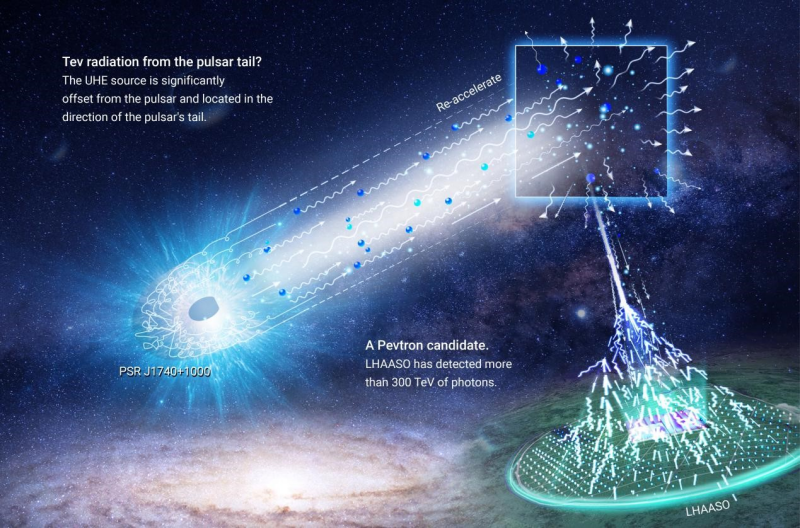LHAASO Discovers Ultra-high-energy Gamma-ray Radiation from the Tail of Bow-shock Pulsar Wind Nebula
The Large High Altitude Air Shower Observatory (LHAASO), a major national science and technology infrastructure project in China, has achieved a groundbreaking discovery in gamma-ray astronomy. Using over 1,200 days of observational data, LHAASO detected ultra-high-energy gamma-ray radiation from the tail region of the bow-shock pulsar wind nebula (BSPWN) associated with the pulsar PSR J1740+1000 with a significance of 17 standard deviations. This marks the first observation of gamma-ray radiation from the tail of a bow-shock pulsar wind nebula, challenging existing theories on particle transport mechanisms and suggesting the presence of a robust particle acceleration process in this region. The findings were published on February 7, 2025, in the academic journal The Innovation.
The research was conducted by the LHAASO collaboration, led by the Institute of High Energy Physics (IHEP) of the Chinese Academy of Sciences. The corresponding authors include XU Renfeng (PHD student), CHEN Songzhan, XI Shaoqiang and HU Shicong from IHEP, as well as WANG Kai (PHD student) and LIU Ruoyu from Nanjing University.
Pulsars are highly magnetized, rotating neutron stars formed from the remnants of massive progenitor stars following supernova explosions. Pulsar wind nebulae (PWNe) are structures created when relativistic particle winds driven by rapidly rotating pulsars collide with surrounding material. The morphology and radiation of PWNe evolve over time, exhibiting distinct characteristics. Young pulsars, often located within supernova remnants, possess high rotational energy and drive powerful pulsar winds that propagate outward at speeds approaching the speed of light. These winds carry away the pulsar's rotational energy, gradually slowing its spin. The violent interaction between the pulsar wind and the surrounding medium converts part of the wind's kinetic energy into the energy of high-energy particles, which then emit radiation across the electromagnetic spectrum, from radio to gamma-rays, through processes such as synchrotron radiation and inverse Compton scattering. As pulsars age and their rotational energy diminishes, the number and maximum energy of high-energy particles in their nebulae decrease. However, particles previously accelerated by the pulsar can spread out, forming gamma-ray halos extending up to hundreds of light-years. Some pulsars escape their supernova remnants and interact directly with the interstellar medium. Due to the pulsar's supersonic motion, a bow-shock pulsar wind nebula, resembling a “comet-like” structure, is formed. While the tail radiation of such nebulae has been observed in radio and X-ray bands, gamma-ray radiation from these regions had remained undetected until now.
PSR J1740+1000 is an isolated pulsar located approximately 4,500 light-years from Earth, far from the galactic disk. With a characteristic age of 110,000 years, it is a middle-aged pulsar. In the X-ray band, a distinct “comet-like” structure caused by its bow shock has been clearly observed. The LHAASO collaboration identified a point-like ultra-high-energy gamma-ray source (referred to as the LHAASO source) at a distance of about 16 light-years from the pulsar. This discovery has two important implications. First, it rules out the existence of a large-scale gamma-ray halo, indicating that not all middle-aged and older pulsars form observable gamma-ray halos, which may be related to their surrounding environments. Second, no other known astrophysical objects capable of accelerating high-energy particles were found near the LHAASO source. Remarkably, the LHAASO source lies precisely along the extension of the bow-shock pulsar wind nebula tail of PSR J1740+1000, revealing that the tail region of a bow-shock pulsar wind nebula can produce ultra-high-energy gamma-ray radiation.

Fig 1:Schematic illustration of the ultra-high-energy gamma-ray radiation observed by LHAASO, produced by re-accelerated particles in the tail region of a bow-shock pulsar wind nebula.
The detected gamma-ray photons have energies exceeding 300TeV, suggesting that the tail of the bow-shock pulsar wind nebula may possess the capability to accelerate particles to PeV energies. This finding provides new insights into the particle acceleration mechanisms in pulsar wind nebulae and opens a new window for studying high-energy astrophysical processes, see as Fig.1.
LHAASO is located at an altitude of 4,410 meters on Haizi Mountain in Daocheng County, Sichuan Province. It began regular operation in July 2021 and is recognized as a leading international facility for gamma-ray and cosmic-ray detection. The LHAASO collaboration has achieved significant results in multiple areas of physics based on its experimental data. This discovery represents another major accomplishment in gamma-ray astronomy for LHAASO. This research was supported by funding from the National Natural Science Foundation of China and other grants.
Online Article URL: https://doi.org/10.1016/j.xinn.2025.100802